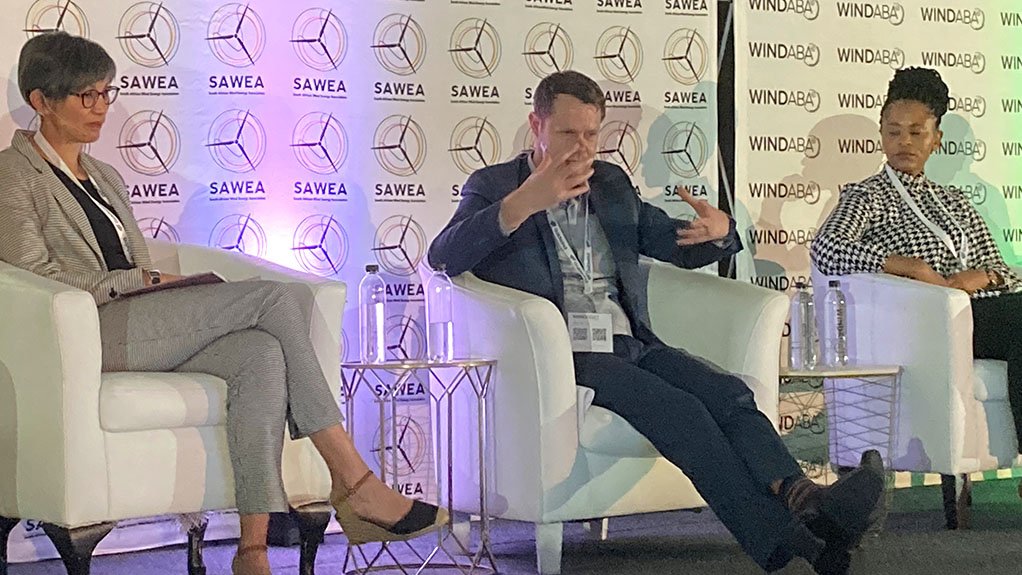Jobs first or energy first, asks Windaba panel
Manufacturing is responsible for only one-third of jobs within the wind energy sector, says Siemens Gamesa Renewable Energy Africa area director Marcel Cabral.
Speaking at Windaba 2022 in Cape Town on Thursday on a panel discussion around localisation in the wind sector, Cabral noted that the other two-thirds revolved around the development, construction, running and maintenance of wind farms, and that “South Africa has all the resources for that”.
He said the lifecycle of a wind farm was quite long, with numerous and varied job opportunities created over the six to ten years of development, up to the decommissioning process 30 years later.
Cabral compared the French wind industry, which did not have local manufacturing and employed 20 000 people, to Spain, which did manufacture and had a 30 000-strong job contingent.
These countries had roughly the same installed wind-energy capacity.
Mainstream Renewable Energy South Africa Africa GM Hein Reyneke noted that the local wind industry had been able to localise more than 40% of its supply chain in terms of value spend.
That totalled R25-billion in investment “straight into the South African economy”.
He also said that South Africa had achieved “a lot” in enabling the deployment of wind energy in the country.
“From my perspective government has moved a lot to enable the industry; to enable a liberalised market . . . yes, we should have had these reforms a decade ago, but have it now.”
Reyneke added that no province should fear being left out of the renewable energy transition and thus, the new-energy jobs loop.
“There is absolutely no way we can deliver on the energy needs of South Africa and not renewable energy everywhere we can, and that includes Mpumalanga, KwaZulu-Natal and Limpopo.
“We need 60 GW quite soon. We need it everywhere, and we need grid everywhere. There has never been a scenario where renewable energy sits in provinces with the highest [sun, wind] resources and the other provinces have nothing.”
Cabral concurred, questioning whether wind farms shouldn’t be rolled out to provinces where the resource is perhaps not perfect, but still available, even if it would require a different cost and payment structure from government and the private sector.
ENERTRAG South Africa project development head Mercia Grimbeek noted that coal-rich Mpumalanga didn’t perhaps offer wind and sun resources equal to that of the Northern Cape and Western Cape, but that they were still better than what was available in Europe.
Energy or Jobs First?
Reyneke believed that the focus should be first and foremost on getting as much energy as possible into the South African grid, and questioned whether viable renewable projects should be held up if they cannot meet a particular localisation challenge.
“We are losing thousands of jobs because we don’t have energy; because of loadshedding.
“I’m not saying we must forget about localisation and job creation, but we must find a balance, because energy creates jobs and economic growth across all sectors.”
Aurora Wind Power CEO Luyanda Jonas-Kortjaas differed from Reyneke, noting that localisation was key.
“What use is growing the renewable energy industry when you leave the rest of the country behind? We need to create energy, but we also need to create jobs. We can focus on getting energy into the grid, but we must make sure we are also growing the local industry.”
Pele Green Energy executive director Obakeng Moloabi said it was important to elevate both to address the “very clear” energy and job crises in South Africa.
Grimbeek noted that the renewable energy sector would, unfortunately, never be able to create one job for every job lost in the coal sector within the just transition process.
Comments
Press Office
Announcements
What's On
Subscribe to improve your user experience...
Option 1 (equivalent of R125 a month):
Receive a weekly copy of Creamer Media's Engineering News & Mining Weekly magazine
(print copy for those in South Africa and e-magazine for those outside of South Africa)
Receive daily email newsletters
Access to full search results
Access archive of magazine back copies
Access to Projects in Progress
Access to ONE Research Report of your choice in PDF format
Option 2 (equivalent of R375 a month):
All benefits from Option 1
PLUS
Access to Creamer Media's Research Channel Africa for ALL Research Reports, in PDF format, on various industrial and mining sectors
including Electricity; Water; Energy Transition; Hydrogen; Roads, Rail and Ports; Coal; Gold; Platinum; Battery Metals; etc.
Already a subscriber?
Forgotten your password?
Receive weekly copy of Creamer Media's Engineering News & Mining Weekly magazine (print copy for those in South Africa and e-magazine for those outside of South Africa)
➕
Recieve daily email newsletters
➕
Access to full search results
➕
Access archive of magazine back copies
➕
Access to Projects in Progress
➕
Access to ONE Research Report of your choice in PDF format
RESEARCH CHANNEL AFRICA
R4500 (equivalent of R375 a month)
SUBSCRIBEAll benefits from Option 1
➕
Access to Creamer Media's Research Channel Africa for ALL Research Reports on various industrial and mining sectors, in PDF format, including on:
Electricity
➕
Water
➕
Energy Transition
➕
Hydrogen
➕
Roads, Rail and Ports
➕
Coal
➕
Gold
➕
Platinum
➕
Battery Metals
➕
etc.
Receive all benefits from Option 1 or Option 2 delivered to numerous people at your company
➕
Multiple User names and Passwords for simultaneous log-ins
➕
Intranet integration access to all in your organisation



















